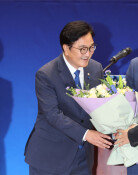New semiconductor war
Semiconductors go in and out of fashion as cars do. In the 1970s, the DRAM chip market was dominated by American chipmakers such as Intel. In the 1980s, when the advent of large computers required high-performance memory chips, Japanese chipmakers were the most dominant. In the 1990s, the era of personal computers, small and cheap semiconductors were popular as high-performance DRAM chips were a waste of money. Samsung Electronics, which mass produced DRAMs for PCs, quickly caught up with their Japanese rivals. In this age of smartphones and tablet computers, who will dominate the market for mobile DRAM chips that consume less power?
Samsung reaffirmed its dominance in the memory chip market Wednesday, when it marked the start of its mass production of 20-nano DRAM and flash memory chips at its plant in Giheung, Gyeonggi Province. The structure of the global semiconductor production market as characterized by one tiger (Samsung) and three cats (Hynix Semiconductor, Elpida Memory and Micron Technology) remains unchanged. Japans Elpida raised eyebrows in May by announcing a plan to mass produce the worlds first 25-nano DRAM chips from July. The company, however, has come up with just prototypes and failed to challenge Samsungs 18-year reign. Hynix, the worlds No. 2 maker of memory chips, will begin to mass produce 20-nano chips early next year.
As one nano-meter is one-billionth of a meter, a chip`s circuit width of 1/4,000th of a human hair is hard to imagine. Samsung plans to churn out 10-nano DRAM chips next year that are considered the technological limit. In the past, the company simply mass produced DRAM and NAND flash memory chips that have been developed by more advanced companies in the U.S. and Japan. The Korean chipmaker developed the worlds first nano DRAM chips in 2006, however, and has since led the global market by introducing more advanced products every year. The follower has become the leader.
Semiconductor makers usually develop next-generation chips before mass producing the current generation. Samsung has enjoyed the leaders advantage as it developed the next next-generation chips. Samsung Electronics Chairman Lee Kun-hee encouraged Samsungs aggressive investment at a time when Japanese and Taiwanese makers were considering reducing production due to falling DRAM prices this year. In a ceremony to mark the production of 20-nano chips Wednesday, Lee cautioned against a strong storm in the semiconductor industry. A huge war lies ahead for Samsung over the next generation of semiconductors such as IBMs PRAM, Samsungs RRAM, Hynixs MRAM and Intels 3-D transistors.
Editorial Writer Hong Kwon-hee (konihong@donga.com)







